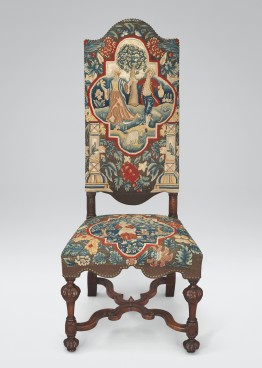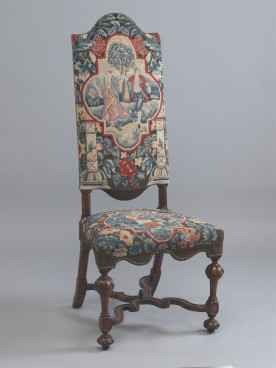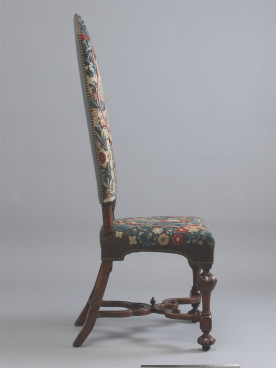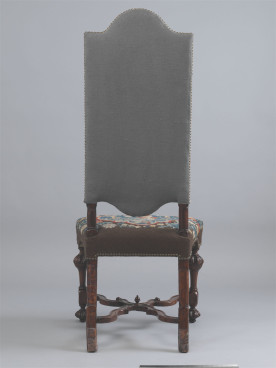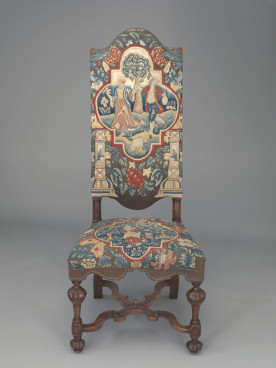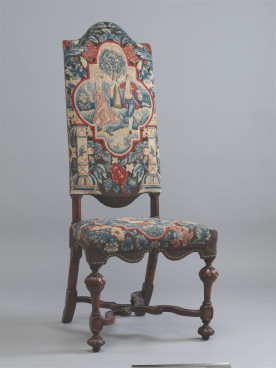Chair, c.1710–15
Walnut and beech, now with early 18th-century needlework
Early eighteenth-century documents refer to this as a cross-frame or cross-stretcher chair. It is one of a pair.
Adam Bowett Catalogue (19/08/2012)
Description
A pair of chairs, c.1710-15. The back is arched at top and bottom and covered with contemporary woollen needlework, as is the seat, which has a scalloped front rail. The pillar front legs are turned with a gadrooned knop and matching compressed ball feet, joined to the raked rear legs with a waved and scrolled X stretcher. There is a small turned finial at the crossing point of the stretchers.
Dimensions
H: 51” (127cm) Seat height: 18 ¼” (46cm) W: 21 ½” (55cm) D: 22“ (56cm)
Materials
Walnut , beech, various upholstery materials
Dating criteria
This is a late variant of the pillar leg form introduced in the 1690s. A key dating point is the raked back leg which indicates a date of after c.1708, but the style of the front legs is unlikely to post-date c.1715, by which time the more fashionable cabriole was being introduced (see Bowett, 1999 & 2002)
Construction
Construction of the back is speculative because enclosed by needlework. Forelegs and back legs as far as the upholstered back are walnut. The beech seat rails are tenoned into all four legs and secured with single pegs. There are no corner braces. The walnut stretcher is made in two parts; each S-shaped diagonal is half lapped in the centre and tenoned into all four legs. These joints are now pegged but it is not possible to determine whether this is original to the construction. The legs and feet have been thicknessed in the usual manner to achieve the necessary dimensions. There are domed gliders on all four feet.
Marks or stamps
22.1 Inside left seat rail is numbered in white pencil 10181, and a circled 2. Inside front seat rail is marked in red pencil 5781.
22.2 Inside left seat rail is numbered in white pencil 10181, and a circled 2.
Condition
22.1 – Condition of the upholstered back is speculative because enclosed by upholstery. The right hand back post has been broken and repaired with a spliced repair, the breakage almost certainly due to weakening by worm. The right back foot has been broken and repaired and the repairs probably screwed and plugged. A similar repair has been effected to the joint between stretcher and right back foot. The left back leg and foot has sustained considerable worm damage and has been consolidated with glue, and/or filler. Front right leg has been fractured at the neck just below the seat, and the foot has been attacked by worm, front left foot ditto. The stretcher has been fractured at one point on the right side and the finial is a replacement. Front seat rail is original, side rails possibly original, rear rail almost certainly replaced. There are repairs to both side rails where they are shaped to meet the legs. There is a fairly recent fracture in the centre of the front seat rail.
22.2 – Filled and repaired worm damage to the left back post above the seat. Left back leg has been fractured and repaired almost certainly as a result of worm damage; there is a spliced repair to left back heel. Spliced repair to top outside corner of right front leg, worm damage to right front foot. Replaced finial to stretcher. There is evidence of an early strap repair beneath the centre of the stretcher, now removed. Rear seat rail possibly replaced, repairs to side rails where they are shaped to meet the legs.
Additional remarks
There is a chair with the same needlework in the V&A
References
For the development of this type of chair see Adam Bowett, ‘The English cross-frame chair, 1694-1715’, The Burlington Magazine (June 2000), pp. 344-352; English Furniture from Charles II to Queen Anne, 1660-1714, Woodbridge, (2002), pp. 242-259.
Tobias Jellinek, Early British Chairs and Seats, Woodbridge (2009), p. 321, pl. 449.
Provenance
Purchased from Fleming and Meers, January 1990

